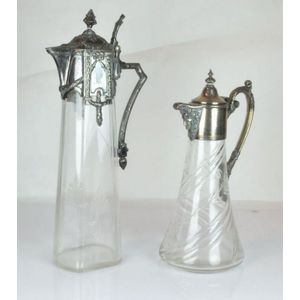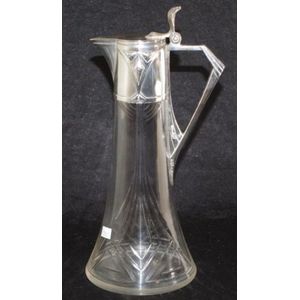Art Nouveau Silverplate and Cut Glass Claret Jug
You must be a subscriber, and be logged in to view price and dealer details.
Subscribe Now to view actual auction price for this item
When you subscribe, you have the option of setting the currency in which to display prices to $Au, $US, $NZ or Stg.
- Art Nouveau Period - The Art Nouveau period was a cultural movement that emerged in the late 19th century, and was characterized by its emphasis on natural forms, flowing lines, and a decorative, ornamental style. Art Nouveau was a reaction against the ornate and heavily stylized designs of the previous era, and sought to create a new, more organic aesthetic.
Art Nouveau was characterized by its use of sinuous, curving lines, as well as a focus on natural elements such as flowers, vines, and other organic shapes. Art Nouveau designers sought to create a total work of art, in which every element of a building or object was designed to be harmonious with the overall design.
Some of the most iconic examples of Art Nouveau design include the Paris Metro entrances designed by Hector Guimard, the works of the artist Alphonse Mucha, and the architecture of Victor Horta in Brussels.
The Art Nouveau period was at its peak between 1890 and 1910, but began to decline in popularity by the start of World War I. However, Art Nouveau remains an important influence on design and art to this day, and continues to be celebrated for its emphasis on natural forms and decorative style. - Cut Glass - Cut glass is glassware decorated with facets, grooves and depressions of various sizes and shapes, made by cutting into the surface of the glass using a rotating abrasive wheel. The glass is ground so the surface consists of facets, which have a high degree of light refraction, so that the surface sparkles.
The techniques of glass cutting had been known since the 8th century BC, and the practice was revived in Bohemia and Germany in the early part of the 16th century and in England in the 18th century. Cutting became the most common method of decorating glass in the second half of the 18th century and the early 19th century. - Circa - A Latin term meaning 'about', often used in the antique trade to give an approximate date for the piece, usually considered to be five years on either side of the circa year. Thus, circa 1900 means the piece was made about 1900, probably between 1895 and 1905. The expression is sometimes abbreviated to c.1900.
This item has been included into following indexes:
Visually similar items

Two silver plated mounts cut glass claret jugs i. WMF tall glass claret jug, makers mark on handle, height 36 cm ii. A silver mount glass claret jug with mask spout, height 29 cm

Victorian silver plated and cut crystal claret jug, 28 cm high approx

A WMF Art Nouveau silver plated liqueur jug, c.1910, with a cut and engraved crystal bowl. Height 24 cm

English sterling silver and crystal ewer, with grape vine handle, and mask spout, above tapering square cut body, height 30c
